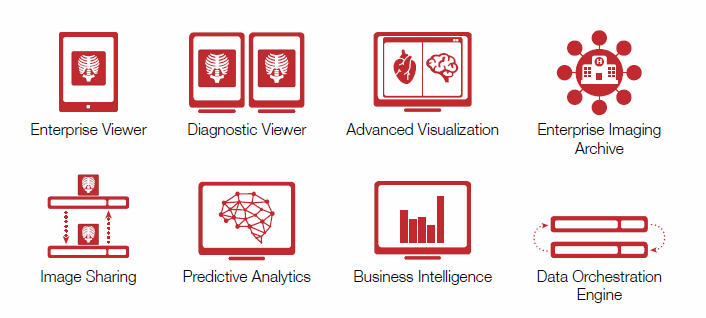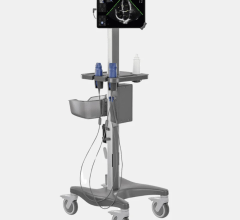
Standards-based interoperability is the key to the use of components critically important to Vital Images’ vision of enterprise imaging. Graphic courtesy of Vital Images
Vital Images has reconciled its vision of the distant future with near term reality. The company has come up with an elegant plan for linking a future with artificial intelligence applications that demand data transfer 24/7 to the means for capturing revenues from exams that might not otherwise be billed out. The two represent different realms of enterprise imaging. The linchpin connecting them is standards-based interoperability.
“We have the ability to connect, gather, share and distribute information from one context to another,” said Larry Sitka, who as Vital Images vice president spoke with Imaging Technology News days before the annual meeting of the Healthcare Information and Management Systems Society (HIMSS). In the coming years the nodes on an enterprise-wide network will increasingly include smart machines “that will be asking for data over and over during a 24-hour day,” Sitka said. “It will be like throwing another thousand users in real time on applications.”
Vital Images Emphasizes Flexibility
The company plans to be ready, evolving its Vitrea platform to handle a future increasingly dependent on smart learning machines. Meanwhile, Vital Images is using standard-based interoperability to resolve ongoing problems, capturing images — and revenue — that would otherwise be lost, said Geoffrey Clemmons, the company’s product marketing manager. Vital Images, he said, is working with customers to identify problems that can be resolved in the near-term with applications that add to the infrastructure of the future, while buoying providers’ coffers.
This pragmatism by the one-time independent company, which operated for years under the Toshiba umbrella and last year formally become a Canon Medical subsidiary, is reflected in a plan whereby its customers can capture revenue and data from the otherwise incidental use of imaging technologies.
Clemmons explained that ultrasonography, for example, performed on a patient in the emergency department complaining of abdominal pain might generate images that could be used by different specialties. An enterprise imaging network might allow access by multiple specialties. And Vital Images also provides the means for making the ultrasound exam itself reimbursable, by documenting use of the ultrasound system as part of business intelligence supported by the network.
How Vital Images Is Breaking With The Past
This approach is a far cry from the traditional one of legacy PACS, which has been to store and secure images for scheduled exams. In this approach, images typically were recalled by specialties, such as radiology or cardiology. In the future, this will be just one task of PACS, Clemmons and Sitka agreed.
The future will be more “about taking the data out, presenting it to the right provider at the right place at the right time in the right context, and being able to do that across systems and across different sites,” Clemmons said.
Such disparate and diverse data recall has been institutionalized by the federal government’s criteria for what constitutes the meaningful use of data, said Sitka who envisions a day when AI applications streamline data exchange. In the years ahead, these AI apps might routinely query data archives many times more frequently than people do now. If this comes to pass, legacy technologies — and iterations based on their underlying model — will not be able to keep up.
“If you take the next iteration of this legacy technology, you are basically locking yourself into the same decisions you made ten years ago,” Clemmons said, “and you will not be prepared.”
Sitka, an engineer by trade, is leading to the evolution of the Vitrea platform so “that it allows interconnectivity to all the information — allows wide accessibility to data — but also provides the means for migrating and coalescing this information as it is needed.”
Flexibility is the key design element, he said. Already this flexibility can be seen in the Vitrea platform. “When you jump on an application going through our system, you see not only what is in that PACS, but every PAC system that is attached to it,” Sitka said.
And the type and volume of patient data will likely increase with the formation of enterprise imaging networks, he said. In future networks, genetic information about the patient suspected of having breast cancer, for example, may be immediately available to the diagnostician along with the mammograms.
Standards-based interoperability will make this possible on the Vitrea platform, Sitka said. It will provide not only the means for viewing images but also performing advanced visualization; image archival and sharing; and the performance of predictive analytics and business intelligence. The ultimate expression of this flexibility — the ability to adapt — will come from standards-base interoperability.
The Role Interoperability Will Play In The Future
Standards-based interoperability that supports centralized data storage will also afford security against cyberattack, Sitka said. And patients will benefit when diagnosticians gain access instantly to their data and images. Achieving these gains, however, will cost money. This is why Vital Images is emphasizing the development of technologies that “form the infrastructure that will position them for tomorrow” yet solves tangible problems today, Clemmons said, for example, capturing and distributing ultrasound images, while documenting its use for reimbursement.
“You have to be able to make a business case to the people who ultimately authorize the spending and you have to present a very valid clinical case so the clinical people are onboard,” he said, noting that Vital Images tries to help its customers identify and address specific problems. “We are very consultative, when we engage with the customer, to identify their largest practical pain points and identify ways that we can help them,” he said.
Applications aimed at pain points help put the basic infrastructure in place. With this, future networks might be scaled more easily and cost efficiently. Similarly, thanks to Vitrea’s use of standards-based interoperability, the platform is evolving compatibly with AI apps developed by Vital Images’ parent Canon, as well as third party developers, Sitka said.
In an effort at future proofing, “we expect not only to be able to provide a platform for our AI services but allow other AI applications to connect to our platform,” he said.
Greg Freiherr is a contributing editor to Imaging Technology News (ITN). Over the past three decades, Freiherr has served as business and technology editor for publications in medical imaging, as well as consulted for vendors, professional organizations, academia, and financial institutions.
Editor's note: In preparation for the upcoming HIMSS (Healthcare Information and Management Systems Society) Conference on Feb. 11, contributing editor Greg Freiherr begins the show coverage with this exclusive podcast and accompanying blog. This is the final podcast in a series of three. You can listen to the first podcast, Hear and Now: How to Boost Cybersecurity in Medical Imaging, here. You can listen to the second podcast, Hear and Now: AI and Imaging, Your Data as Strategic Asset, here.
Related content:
Radiology Information Interoperability for Productivity and Quality



 April 17, 2024
April 17, 2024 








